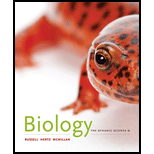
Concept explainers
Introduction:
Bacterial cells can be classified as gram-positive or gram-negative, depending upon the ability to retain the stain. The gram-positive bacteria have a thick layer of peptidoglycan, while the gram-negative bacteria have a thin layer of peptidoglycan cell-wall. The crosslinking of a peptidoglycan in gram-positive bacteria helps it retain the crystal violet stain (
Answer to Problem 1TYK
Correct answer:
Pili keep them attached to the urethral walls.
Explanation of Solution
Explanation/justification for the correct answer:
Option (d) is pili. Pili are the hair-like structures that arise from the cell walls of the bacteria. Pili are mostly present in gram-negative bacteria and help them adhere to a surface like other prokaryotic cells or tissue membranes like the urethral lining in humans. Hence, option (d) is the correct answer.
Explanation for incorrect answer:
Option (a) is sex pili. The sex pili are extended for conjugation, in which the one bacterium exchanges genetic material with another, under adverse conditions. Sex pili do not help in adherence to the host tissues. So, it is an incorrect option.
Option (b) is flagella. Flagella are hair-like extensions that help in the locomotion of a microbe. The flagella move with the help of motor proteins, allowing the bacteria to move from one location to another. So, it is an incorrect option.
Option (c) is capsule. The capsule is a diffused glycocalyx present in the gram-negative bacteria. It protects the bacteria from antibiotic effects. The peptidoglycan of cell-wall protects the bacteria from adverse environments. So, it is an incorrect option.
Therefore, it can be concluded that the bacterial cells that are present in the urethra are gram-negative as their surface is covered with pili that help them adhere to the urethral walls.
Want to see more full solutions like this?
Chapter 26 Solutions
Biology: The Dynamic Science (MindTap Course List)
- How is a protein destined for the Endoplasmic Reticulum (ER), imported into the ER? Be concise.arrow_forwardFind out about the organisations and the movements aimed at the conservation of our natural resources. Eg Chipko movement and Greenpeace. Make a project report on such an organisation.arrow_forwardWhat are biofertilizers and mention the significancearrow_forward
- PCBs and River Otters: Otters in Washington State’s Green-Duwamish River have high levels of polychlorinated biphenyls (PCBs) in their livers. PCBs can bind to the estrogen receptors in animals and disrupt the endocrine system of these otters. The PCBs seem to increase the estrogen to androgen ratio, skewing the ratio toward too much estrogen. How would increased estrogen affect the river otter population? Based on your reading of the materials in this unit, what factors can affect fertility in humans? Explain how each of the factors affecting human fertility that you described can disrupt the human endocrine system to affect reproduction.arrow_forwardOther than oil and alcohol, are there other liquids you could compare to water (that are liquid at room temperature)? How is water unique compared to these other liquids? What follow-up experiment would you like to do, and how would you relate it to your life?arrow_forwardSelection of Traits What adaptations do scavengers have for locating and feeding on prey? What adaptations do predators have for capturing and consuming prey?arrow_forward
- Competition Between Species What natural processes limit populations from growing too large? What are some resources organisms can compete over in their natural habitat?arrow_forwardSpecies Interactions Explain how predators, prey and scavengers interact. Explain whether predators and scavengers are necessary or beneficial for an ecosystem.arrow_forwardmagine that you are conducting research on fruit type and seed dispersal. You submitted a paper to a peer-reviewed journal that addresses the factors that impact fruit type and seed dispersal mechanisms in plants of Central America. The editor of the journal communicates that your paper may be published if you make ‘minor revisions’ to the document. Describe two characteristics that you would expect in seeds that are dispersed by the wind. Contrast this with what you would expect for seeds that are gathered, buried or eaten by animals, and explain why they are different. (Editor’s note: Providing this information in your discussion will help readers to consider the significance of the research).arrow_forward
 Biology: The Dynamic Science (MindTap Course List)BiologyISBN:9781305389892Author:Peter J. Russell, Paul E. Hertz, Beverly McMillanPublisher:Cengage Learning
Biology: The Dynamic Science (MindTap Course List)BiologyISBN:9781305389892Author:Peter J. Russell, Paul E. Hertz, Beverly McMillanPublisher:Cengage Learning Concepts of BiologyBiologyISBN:9781938168116Author:Samantha Fowler, Rebecca Roush, James WisePublisher:OpenStax College
Concepts of BiologyBiologyISBN:9781938168116Author:Samantha Fowler, Rebecca Roush, James WisePublisher:OpenStax College Biology 2eBiologyISBN:9781947172517Author:Matthew Douglas, Jung Choi, Mary Ann ClarkPublisher:OpenStaxBasic Clinical Lab Competencies for Respiratory C...NursingISBN:9781285244662Author:WhitePublisher:Cengage
Biology 2eBiologyISBN:9781947172517Author:Matthew Douglas, Jung Choi, Mary Ann ClarkPublisher:OpenStaxBasic Clinical Lab Competencies for Respiratory C...NursingISBN:9781285244662Author:WhitePublisher:Cengage





